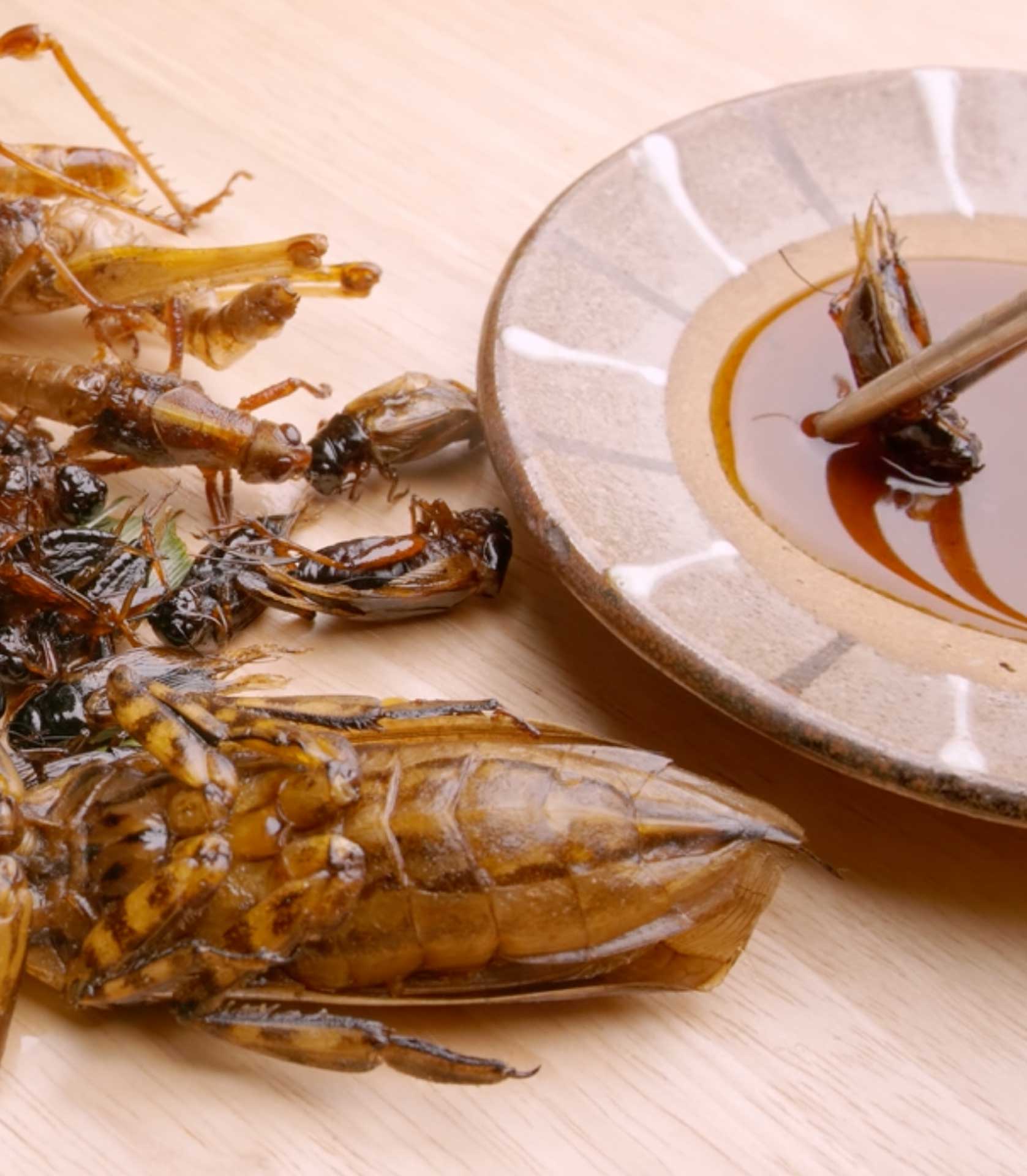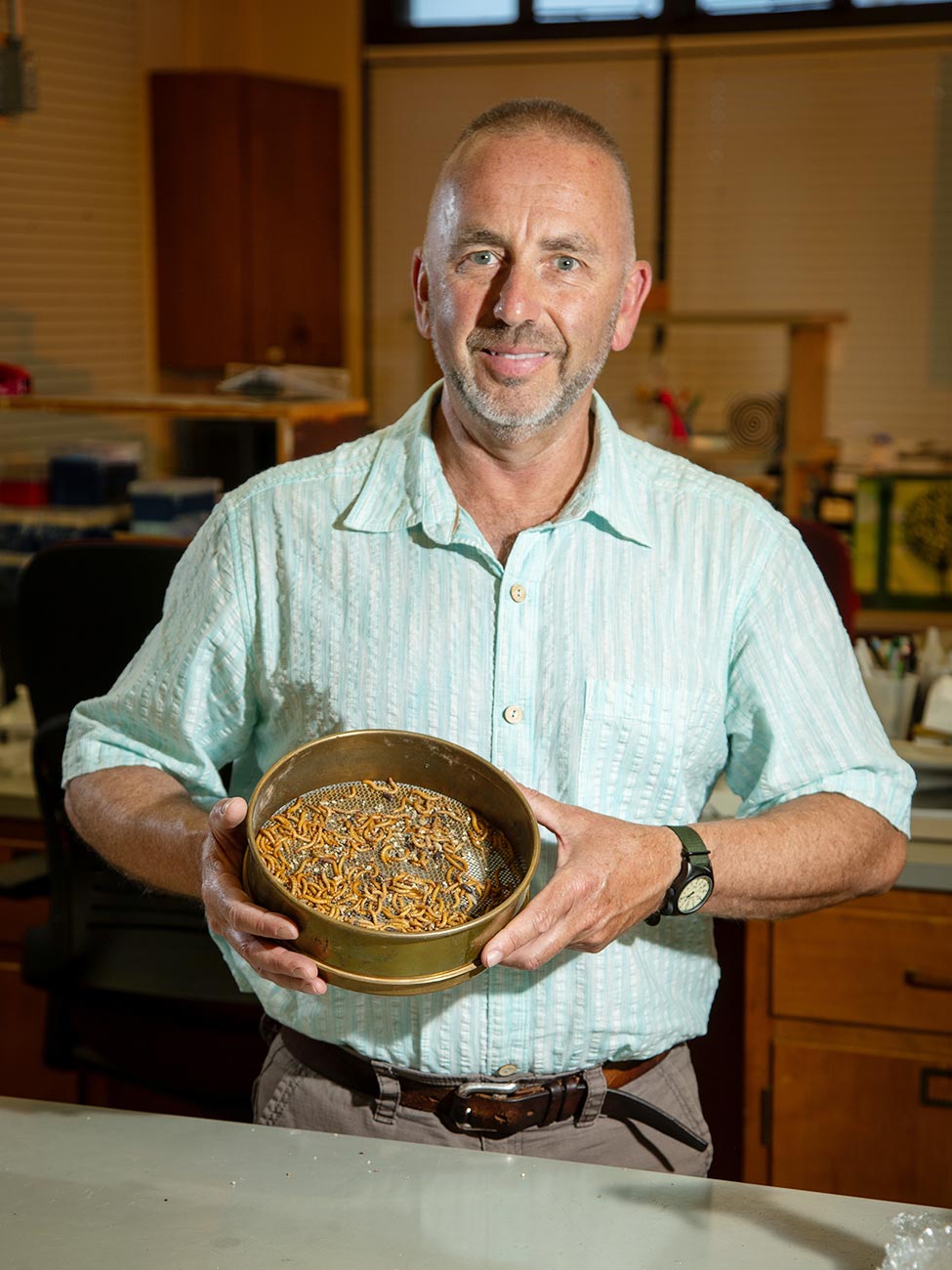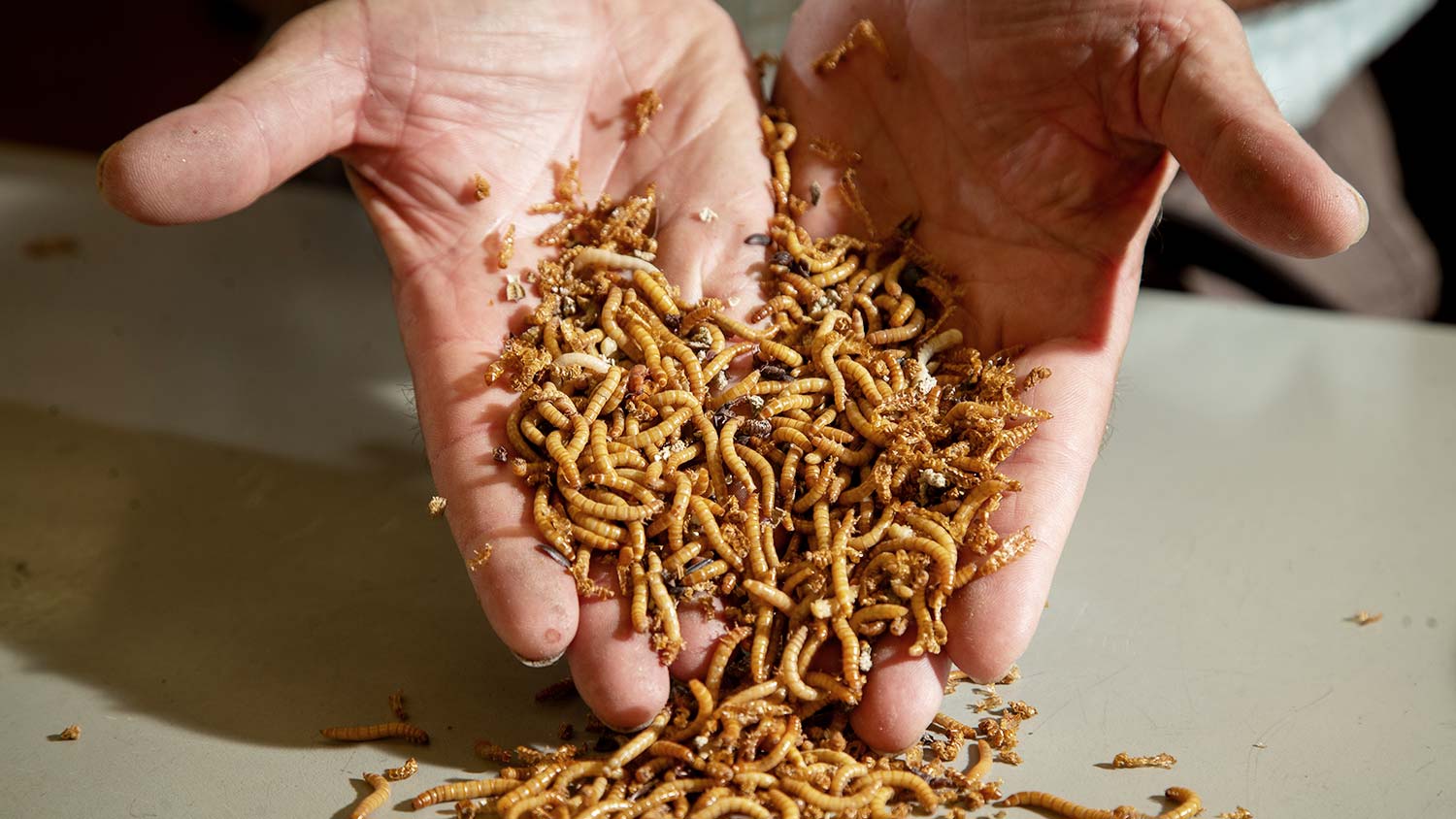University of California, Riverside

Good Grub
Two UCR entomologists share their insights on insects as a food source and why more people should consider including bugs in their diet
More than 2 billion people regularly eat insects — on purpose. They’re a great source of protein for communities around the world and some are considered delicacies reserved for special occasions. And it’s entirely possible that eating bugs could become more common in the U.S. too.
To discuss why the practice of eating arthropods, or entomophagy, is gaining in popularity, UCR Magazine called on Erin Wilson-Rankin, a professor in the Department of Entomology. She teaches a course for nonmajors about the history of insects, including who eats them and why.
Below the Q&A, Mark Hoddle, director of UCR’s Center for Invasive Species Research, shares how a palm weevil infestation in Laguna Beach led him to Southeast Asia, where his field work came with a side of deep-fried grubs.
The Ins and Outs of Entomophagy
Entomologist Erin Wilson-Rankin discusses the benefits of bug eating and why Western countries should embrace it
How do you introduce students to the concept of eating insects?
The first thing I want to do is emphasize that this practice is not weird. There are 8 billion people in the world. If more than 2 billion are eating bugs, that’s a decent percentage. It is a major source of protein for much of the world.
Which bugs make the most popular hors d’oeuvres?
You’ll find the practice more common in countries closer to the equator. Globally, beetles are the most common insects to be consumed, followed by butterflies and moths. People usually go for the larvae, because they’re soft protein bags of goo, or the pupae, a form in between larva and the adult stage.
There are geographic patterns that determine which insects are the most commonly eaten. Caterpillars are super popular in sub-Saharan Africa. You’ll find ants, wasps, and bees are most common in Latin America, where they’re very abundant. In Colombia, they roast ants and make flour from them. People collect ant larvae from agave fruits and put them in burritos or garlic sauce.

Wilson-Rankin teaches a course about entomophagy to nonmajors. (UCR/Stan Lim)
What are some of the benefits of eating bugs?
Raising insects for food does not impact the environment in the same way that chicken or beef does. It’s more sustainable, so even people who prefer avoiding beef and chicken may be inspired to use this as a form of protein because of the environmental benefits. Way fewer greenhouse gases are involved compared to raising pigs or cattle. It is just a more sustainable way to feed people and could help contribute to global food security.
It varies depending on the insect you’re farming, and whether we’re talking about larvae or an adult insect, but let’s compare some basic numbers: For 100 pounds of grass, you can produce 3 pounds of beef, 30 pounds of chicken meat, or 35 pounds of some caterpillars. For the input, you get more protein output.
The most protein per unit of mass are probably going to be your grasshoppers, crickets, and locusts. Those are really high in protein relative to fat. But you’ll get a lot of other things with them, including antioxidants, anti-inflammatories, essential amino acids, and fiber.
Oftentimes, we’re told insects carry bacteria or toxins. Is this a concern when eating them?
Viruses causing foodborne diseases don’t typically replicate in arthropods, but edible insects could become contaminated during processing or distribution. If you’re worried about it, do the same as you would with vegetables or eggs. You wash those before you eat them, too. And as with raw meat, you would cook them as well, which would likely eliminate any major pathogens, like E. coli.
I don’t know of a whole lot of insects that accumulate toxins naturally. There are a few exceptions, like monarch caterpillars that accumulate toxin from milkweed plants to avoid being eaten by predators. But the most commonly eaten species do not bioaccumulate.
Tarantulas do need special preparation but only because their hairs can cause irritation.
Hear Wilson-Rankin discuss the potential of eating insects taking off in the U.S. in the future, and see how many UCR students are willing to give bugs a try today.
Do insects have cholesterol?
Good question! They do have some mono and polyunsaturated fats.
More importantly, in my mind, insects have nutrients in them that you can get from other plant sources, but not from other protein or meat sources. There are antihypertensive components, like anti-inflammatories and antioxidants. We may one day take extracts of these compounds from insects.
What is keeping people in Western countries from eating bugs?
Who says we don’t? It is estimated that an average American eats about 2 pounds of dead insect parts a year in their food that they don’t know about. The Food and Drug Administration sets what is called “food defect action levels,” which determine how much contaminant is allowed in our food supply.
For example, you’re allowed to have 60 or more insect parts per 100 grams of chocolate. Peanut butter is similar. You can also have more than 2,500 aphids per 10 grams of hops used to make beer. Insect fragments in our food are considered an aesthetic problem. Most do not pose a health hazard. There are also certain activities that lend themselves to insect eating. Cyclists eat way more insects than your average non-cyclist because while they’re biking, their mouths are often open. Same with motorcyclists, unless they use full-face helmets.
“Our Western culture has a stereotype that eating insects is gross. We are going to have to fight against that if entomophagy is going to take off in our country.”
Because of the environmental benefits, a lot of Michelin-star chefs have been getting into this. The high-end ice cream parlor Salt and Straw has a Halloween ice cream with mealworms and crickets. Celebrity chef Joseph Yoon is a good spokesperson for the movement, and they serve his recipes at restaurants where people pay upwards of $500 to get in the door. Our Western culture has a stereotype that eating insects is gross. We are going to have to fight against that if entomophagy is going to take off in our country.
There’s a really interesting history. Lobsters are now a delicacy, especially in New England. But, once upon a time, they were scorned as the cockroaches of the sea. People would strike against employers for feeding them too much lobster. Then, lobster got a rebranding, and the general public started to see it differently. I think we need a rebranding for entomophagy.

If You Can’t Beat ’Em, Eat ’Em
A palm weevil infestation in California led entomologist Mark Hoddle to Southeast Asia, where the insects are a delicacy
Think people only eat insects because they cannot afford other sources of protein? Think again. In Thailand, shoppers pay more for palm weevil larvae than they do for chicken. These immature long-snouted beetle grubs can be a landscaper’s nightmare. They feed on and eventually kill the palm trees they infest. But as livestock, the grubs are golden.
“I’ve watched people purchase weevil grubs by the pound for their special occasion dinners,” said UCR entomologist Mark Hoddle.

Hoddle heads UCR’s Center for Invasive Species Research. (UCR/Stan Lim)
There are three main ways the weevils are usually prepared: stir-fried in a wok with basil and chili peppers, prepared as a curry dish with vegetables, or battered and deep fried.
“Deep fried larvae are excellent, and without the head, the consumer would be unaware that the morsel was an insect larva,” Hoddle said. “The dish could easily be passed off as calamari or some type of seafood.”
Though the flavor impressed him, Hoddle was perhaps more impressed by the industrial-scale weevil farms he visited in Thailand that produced them.
“These are low-cost, zero-waste operations,” Hoddle said. “They raise grubs on small plots of land and sell the waste weevil food as a soil amendment. The water that drains from rearing containers is also bottled and sold as liquid fertilizer.”
The story of how he came to observe weevil farms in Southeast Asia connects an insect mystery in Laguna Beach, California, to a commercial insect farming startup in Ghana. Hoddle, who serves as director of UCR’s Center for Invasive Species Research, specializes in the biological control of invasive insects. This means when he gets the call about an infestation, he’ll first look for that insect’s natural enemy before turning to pesticides or other control methods.
This expertise is why he was contacted when palm trees in Laguna Beach started inexplicably dying in 2010. Usually, an invasion has its roots in high levels of trade or tourism. Laguna Beach, however, has neither a major airport nor seaport, and only a few main roadways.
“We knew it was a palm weevil, but we couldn’t work out where on Earth, quite literally, it came from,” Hoddle said.
“Deep fried larvae are excellent, and without the head, the consumer would be unaware that the morsel was an insect larva.”
To work that out, Hoddle and his wife Christina, a fellow entomologist, went to grub-producing farms in the Philippines, Indonesia, Cambodia, Vietnam, Malaysia, and Thailand to collect palm weevils that they could compare, genetically, to the ones found in Laguna Beach. As they sampled the insects for DNA testing — and for taste — they were also treated to tours of the weevil farms.
Two main types of farming techniques were employed. One involves growing the weevils in round plastic containers that would normally be used for holding water or animal feed. Mashed palm fronds are soaked in the tubs, a little pig food is added into the mix, and a few male-female pairs are placed inside. After about a month, farmers are ready to harvest the fat weevil grubs.
The other method is to raise them right inside the cut trunks of the very palm trees they like to infest. The stumps are placed under a tarp for shade, and little other preparation is needed. Farmers place some bark bits and palm mash inside, cover with bark flaps, and let it be. After a couple of months, the first crop of grubs is ready to harvest. The hollowed trunks can be sold as containers for plants.
Along with the weevil grubs, people also eat the pupae, which is the “teenage” transition stage before maturity. In Thailand, the pupae retail for about 400 baht, roughly 11 U.S. dollars, per 2.2-pound bag. The larvae went for roughly 250 baht a bag. For comparison, Hoddle reported nearby supermarkets sold the same quantity of pork for 215 baht, chicken breast for 180 baht, and fish for 69 to 250 baht.
“Weevils are relatively expensive for Southeast Asian locals, compared to other sources of protein,” Hoddle said. “But people are willing to pay because they love it.”
All these observations helped Hoddle inform a group of entrepreneurial Canadian business students looking to start a weevil grub farm in Africa. The group contacted him for specifics on insect production as they were developing their pitch for a $1 million prize from the Clinton Global Initiative. The McGill University students argued that they could combat hunger and nutritional deficiencies in impoverished regions by making insect-based meals affordable for people. And in 2013, they won the prize. After raising additional cash, the Aspire operation launched and continues to thrive in Canada, the U.S., and Ghana.
As for the weevil infestation in Laguna Beach, it is now long gone. Hoddle, along with help from UCR entomologist Paul Rugman-Jones, determined the invasive weevil population was a red palm weevil that likely originated from Bali in Indonesia.
Having identified the threat, UCR joined scientists from the California Department of Food and Agriculture and the U.S. Department of Agriculture in eradicating the red palm weevil through a combination of pheromone traps, insecticides strategically applied to infested palms, and destruction of trees unresponsive to treatment. Based on what he saw abroad, Hoddle speculates that someone may have deliberately introduced these weevils to Laguna Beach to raise as food.

Hoddle holds a handful of mealworms, one of many edible insect types that are still a novelty in the U.S. (UCR/Stan Lim)
Though he does not believe we can eat our way out of an infestation already in progress, there is a name for the farming and eating of invasive species: invasophagy. In the Caribbean, invasive lionfish are sold and eaten. Other countries hunt invasive mammals, like deer, pigs, and rabbits. And of course, palm weevils and other insects make for great grub.
“Before conducting this research on palm weevils, I didn’t know that such a variety of insects were palatable and that so many cultures, mainly in tropical regions, eat insects, pretty much daily,” Hoddle said. “Nor did I know that some species are farmed!”
There is a wide variety of insect species beyond weevil grubs that are suitable for eating. Honeybee larvae, ants, grasshoppers, crickets, katydids, cicadas, rice ear bugs, stink bugs, moths, flying termites, horned beetles, stick insects, silk moth larvae, dragonflies, giant water bugs, spiders, and scorpions, to name a few. Some of these bugs, like crickets, mealworms, and palm weevil larvae, are sometimes referred to as “micro-livestock” and can also be farmed commercially.
Though there are logistical challenges to setting up insect farming operations where an insect is not native, the bigger challenge in Western culture is overcoming the stigma of bug eating.
“There was never an abundance of insects to eat in Europe, so for descendants of Europeans, it isn’t a part of their cultural identity,” Hoddle said. “Because of this, entomophagy in Western culture is pretty much a niche type of thing, and this is unlikely to change anytime soon.”
